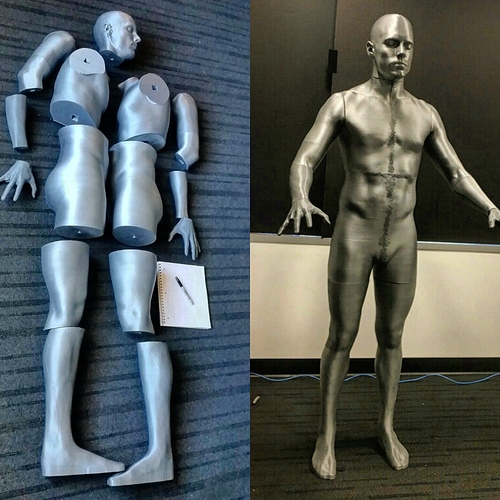Recent R&D project: Life-sized 3d printed mannequin. Used a real human 3d scan chopped up into the build volume of my modified Tevo Little Monster (+ Duet Ethernet, Bondtech, E3D Volcano @ 1.2mm). Not counting calibration and failed prints, the whole thing was printed out of 12kg of Push Plastics PETG in 5 days & 17 hours, at 600 micron. By far the biggest single thing I’ve printed, learned a lot! 
You cut off his penis!
@Kevin_Danger_Powers : He was was wearing some tighty-whities during the scan. But the mooseknuckle did have to be smoothed out. Still didn’t make it not weird to have a life-sized package in my printroom…
@Kevin_Danger_Powers The organ will be separately customized to individual requirements . Other actuators will be attached according to functions which a Humanoid Robot is to perform .
good work… sad to see how a simple 3d print quality conversation goes in the most unwanted direction… why are some people obsessed with the absence of the required tools!
The body part pic reminds me of an episode of Dexter
Awesome job!
Very nice! I’d very much like to do a life size project such as this but haven’t found much information or examples. To 3D print an object this big (although in pieces), what type of polygon size/resolution would you need the figure to be? I know your print was a actual 3D scan, but could this be done with smaller character meshes and scaled higher to print this good?
In theory, I was thinking of taking a character mesh and clothing from something like DAZ3d (low mesh), import into Zbrush to modify and maybe subdivide to be a heavier mesh, and then print.
the resolution on this asset wasn’t much higher than anything else I’d normally print. Most ‘small’ prints have far more poly resolution than can actually be printed. What I tell people to do to visualize this is: In your 3d App: Set all ‘normals to face’ (or analogs term). Basically, ‘make it look faceted, not smooth’. Now, zoom the camera so that you’re viewing a roughly life-sized version of the print. what you see on-screen should be about how it will look printed (ignoring z-resolution, and xy nozzle resolution). If it looks too faceted, then smooth it more. If not, print!
Thank you for taking the time to respond to my inquiry. I’ve just
purchased a CR-10S and it should arrive sometime before the holidays.
On a life-size print like yours, would you recommend a .6mm print nozzle?
